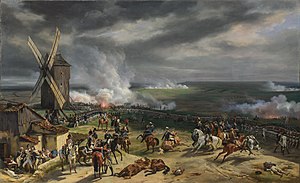
Back معركة فالمي Arabic والمی دؤیوشو AZB Битка при Валми Bulgarian Emgann Valmy BR Batalla de Valmy Catalan Bitva u Valmy Czech Kanonade von Valmy German Μάχη του Βαλμί Greek Batalo de Valmy EO Batalla de Valmy Spanish
| Battle of Valmy | |||||||
|---|---|---|---|---|---|---|---|
| Part of the War of the First Coalition | |||||||
 The Battle of Valmy by Horace Vernet, 1826. The white-uniformed infantry to the right are regulars while the blue-coated ranks to the left represent the citizen volunteers of 1791. The Moulin de Valmy was burnt on the orders of Kellermann on the day of the battle. | |||||||
| |||||||
| Belligerents | |||||||
|
|
| ||||||
| Commanders and leaders | |||||||
|
|
| ||||||
| Strength | |||||||
| 36,000 | 34,000 | ||||||
| Casualties and losses | |||||||
| ~300 | ~200 | ||||||
Location within Europe | |||||||
The Battle of Valmy, also known as the Cannonade of Valmy, was the first major victory by the army of France during the Revolutionary Wars that followed the French Revolution. The battle took place on 20 September 1792 as Prussian troops commanded by the Duke of Brunswick attempted to march on Paris. Generals François Kellermann and Charles Dumouriez stopped the advance near the northern village of Valmy in Champagne-Ardenne.
In this early part of the Revolutionary Wars—known as the War of the First Coalition—the new French government was in almost every way unproven, and thus the small, localized victory at Valmy became a huge psychological victory for the Revolution at large. The outcome was thoroughly unexpected by contemporary observers—a vindication for the French revolutionaries and a stunning defeat for the vaunted Prussian army. The victory emboldened the newly assembled National Convention to formally declare the end of monarchy in France and to establish the French Republic. Valmy permitted the development of the Revolution and all its resultant ripple effects, and for that it is regarded by historians as one of the most significant battles in history.
